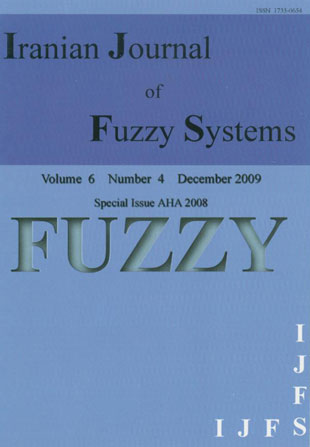فهرست مطالب

Iranian journal of fuzzy systems
Volume:6 Issue: 4, Dec 2009
- 90 صفحه،
- تاریخ انتشار: 1388/09/20
- تعداد عناوین: 7
-
-
Pages 1-9In this paper, we study fuzzy substructures in connection with Hv-structures. The original idea comes from geometry, especially from the two dimensional Euclidean vector space. Using parameters, we obtain a large number of hyperstructures of the group-like or ring-like types. We connect, also, the mentioned hyperstructures with the theta-operations to obtain more strict hyperstructures, as Hv-groups or Hv-rings (the dual ones).
-
Pages 11-19On a hypergroupoid one can define a topology such that the hy- peroperation is pseudocontinuous or continuous. In this paper we extend this concepts to the fuzzy case. We give a connection between the classical and the fuzzy (pseudo)continuous hyperoperations.
-
Pages 21-36In a ternary semihyperring, addition is a hyperoperation and multiplication is a ternary operation. Indeed, the notion of ternary semihyperrings is a generalization of semirings. Our main purpose of this paper is to introduce the notions of fuzzy hyperideal and fuzzy bi-hyperideal in ternary semihyperrings. We give some characterizations of fuzzy hyperideals and investigate several kinds of them.
-
Pages 37-47In this note, we introduce the concept of a fuzzy filter of a BL- algebra, with respect to a t-norm briefly, T-fuzzy filters, and give some related results. In particular, we prove Representation Theorem in BL-algebras. Then we generalize the notion of a fuzzy congruence (in a BL-algebra) was defined by Lianzhen et al. to a new fuzzy congruence, specially with respect to a t- norm. We prove that there is a correspondence bijection between the set of all T-fuzzy filters of a BL-algebra and the set of all T-fuzzy congruences in that BL-algebra. Next, we show how T-fuzzy filters induce T-fuzzy congruences, and construct a new BL-algebras, called quotient BL-algebras, and give some homomorphism theorems.
-
Pages 49-59The operations in the set of fuzzy numbers are usually obtained by the Zadeh extension principle. But these definitions can have some disadvan- tages for the applications both by an algebraic point of view and by practical aspects. In fact the Zadeh multiplication is not distributive with respect to the addition, the shape of fuzzy numbers is not preserved by multiplication, the indeterminateness of the sum is too increasing. Then, for the applications in the Natural and Social Sciences it is important to individuate some suitable variants of the classical addition and multiplication of fuzzy numbers that have not the previous disadvantage. Here, some possible alternatives to the Zadeh operations are studied.
-
Pages 61-72Let R be a commutative hyperring with identity. We introduce and study prime fuzzy hyperideals of R. We investigate the Zariski topology on FHspec(R), the spectrum of prime fuzzy hyperideals of R.
-
Pages 73-87In this paper, we deal with Molaei’s generalized groups. We de- fine the notion of a fuzzy generalized subgroup with respect to a t-norm (or T-fuzzy generalized subgroup) and give some related properties. Especially, we state and prove the Representation Theorem for these fuzzy generalized subgroups. Next, using the concept of continuity of t-norms we obtain a cor- respondence between TF(G), the set of all T-fuzzy generalized subgroups of a generalized group G, and the set of all T-fuzzy generalized subgroups of the corresponding quotient generalized group. Subsequently, we study the quo- tient structure of T-fuzzy generalized subgroups: we define the notion of a T-fuzzy normal generalized subgroup, give some related properties, construct the quotient generalized group, state and prove the homomorphism theorem. Finally, we study the lattice of T-fuzzy generalized subgroups and prove that TF(G) is a Heyting algebra.

